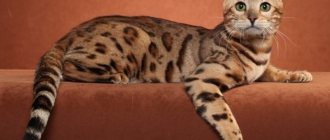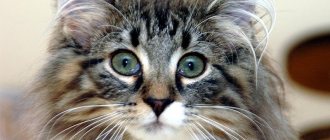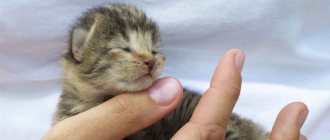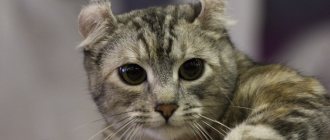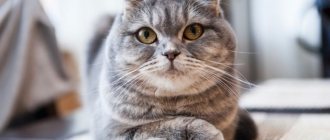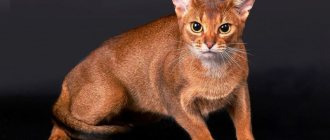History of the breed
The state of Burma or in modern Myanmar in Southeast Asia is considered the place where the Burmese cat breed originated. According to legend, the ancestors of the Burmese cat lived in ancient temples and were revered as sacred animals. The distribution of the Burmese cat was supposed only within the kingdom.
Only in 1930, Mr. Joseph Cheeseman Thomson, an American doctor who visited this end of the earth, was able to get a kitten named Wong Mau. The Burmese received further development in San Francisco, where it was bred with a Siamese cat named Tai Mei. As a result of selection, kittens were born with the features of the Burmese mother and similar to the Siamese cat. The breed was not very attractive to cat lovers; they were considered Siamese mestizos. In 1936, the breed “Burmese cat” or translated as “Burmese cat” was officially registered in the USA according to the CFA standard. The American branch was formed from an exotic Burmese with a chocolate coat and a striking golden-amber eye color.
The Burmese appeared in Europe later, and selection work was also carried out there, but in a different direction. The public's first delight was in 1955 when a blue Burmese cat, nicknamed “Cat - the Blue Miracle,” received a blue color at an exhibition in London. From him came the European branch of the Burmese cat.
The American Burmese and European are different branches of Burmese cats, which are recognized as independent breeds with an individual description of the standard.
Burmese women of both branches have gained popularity all over the world, they have conquered distant Australia. In Russia, Burmese cats are not yet very common; their population is growing every year; both domestic nurseries have appeared, as well as in the countries of the former USSR.
Mr. Cat explains: Choosing a kitten and price
The popularity of this breed is off the charts. Therefore, the price in Europe for Burmese reaches $1,000.
In Russia, representatives of the pet class breed are sold for an average of 10-15 thousand rubles. But you can buy an elite kitten and future show champion for no less than 20-60 thousand rubles.
For true admirers of the breed, cost will not be an obstacle. The Burma will not only decorate any home, but will also relieve the owners from loneliness, as well as some diseases.
Burmese cat breed description
The description of the Burmese cat breed of the European and American varieties includes various characteristics that the animal meets according to the standard.
Table No. 1
| Breed: Burmese, origin: Burma or modern Myanmar | |||
| External data | Description European branch | Description American branch | Note |
| Year of first registration | 1955 | 1936 | Both branches of the breed are registered as independent. |
| Body, body, chest | Small, flexible body with a developed chest. | Heavy build with a well-developed rounded chest. | The European Burmese looks more graceful. |
| Paws, limbs | The limbs are thin, of medium length, proportional to her body. With oval shaped paws. There are five toes on the front legs and four on the hind legs. | All paws are in symmetrical white “socks”. | |
| Tail | Medium length, without bends, tapering and rounded at the end | Same for both species. | |
| Head | Round shape. | Wedge-shaped. | — |
| Neck | Long, thin, strong | — | |
| Muzzle | Wide, wedge-shaped. | Round shape, with full cheeks. | — |
| Forehead | The frontal part of the breed's skull is smoothly rounded. | Same for both species. | |
| Eyes, iris color | The eyes are slanted, large with a slight slope towards the nose. The color of the iris is honey-amber. | Large, round in shape, set wide apart, have a childish expression. — | — |
| Ears | Medium-sized, inclined forward and widely spaced. | The ears are medium-sized, widely spaced and rounded at the ends. | — |
| Wool | Short-haired with a fine and silky coat without undercoat, lying close to the body. | The American species has four shades of coat, the European has nine. | |
| Average height at withers 30 cm | |||
| Average weight of an adult female | Up to 5 kg | The European Burmese weighs less | |
| Average weight of an adult male. | Up to 8 kg | ||
| average life expectancy | Up to 15 years | For diabetes and hypokalemia up to 10 years of age | |
European Burmese
The European Burmese have their own individual standards in the shape of their eyes, ears and appearance:
- The muzzle is wedge-shaped.
- The medium-sized ears slope forward and are set wide apart.
- The eyes are slanted, large with a slight slope towards the nose.
- Long limbs with rounded paws.
- According to the standard, it has 9 colors: solid (brown, blue, chocolate, lilac, red, cream) and four tortoiseshell (brown tortoiseshell, blue tortoiseshell, chocolate tortoiseshell and lilac tortoiseshell).
American Burmese
According to the standard of the shape of the eyes, ears and appearance, the American Burmese has:
- The muzzle is round with a clear chin,
- The ears are medium-sized, widely spaced and rounded at the ends.
- The round, big eyes look childishly surprised.
- According to the standard, it has four main colors;
- Provides four possible colors of cats: sable, blue, champagne, lilac.
Important! The main significant difference between the American Burmese and the European Burmese is the number of colors and their shades. Purple and blue colors are present in both varieties.
Colors
Colors and patterns are the main difference between the American and European varieties of cats.
Rare coat colors give the Burmese cat special beauty and elegance, emphasizing the silkiness of the soft, shiny coat.
Kittens are very light in color at birth, which gradually changes until about two years of age.
Champagne (chocolate)
Brown color
Sable (black)
Cream color
Red color
Tortoiseshell color
Chocolate tortoiseshell
lilac color
Blue color
Table No. 2 Colors of the Burmese cat of the American and European varieties.
| Type of color | Description | Note |
| Sable (black) | The most common, with the darkest coat, is sable, which combines dark brown and black. It is believed that the type of sable color is similar to the precious fur of a sable. Nose, paw pads, as the main coat color | Characteristic of the American branch. |
| Champagne or chocolate | The color is different in that it looks like milk chocolate. It has shades from light to darker, colder. Nose, paw pads of a similar color or tone of cinnamon. | |
| Brown | The most popular brown coat is the Burmese, which comes in different shades. The nose and paw pads have a chocolate tint | Characteristic of the European branch. |
| Reds | Red Burmese with an unusual, rare color reminiscent of a tangerine. The nose and paw pads are also red. | |
| Cream | Lightened soft apricot tone. The nose and paw pads are the color of condensed cream. | |
| Tortoiseshells | Available in various colors. Varieties of tortoiseshell tones look unusual compared to solid colors. | |
| Chocolate turtle | Red markings look good on brown, and the nose and paw pads are dark pink. | |
| Lilac tortoiseshell | Warm lilac with cream coat and bluish-gray paw pads and nose. | |
| Blue tortoiseshell | An interesting combination of blue color with cream coat and pink nose and paw pads. | |
| Blue | Blue Burmese, an elite cat with a cool gray tone that can cast a steel-like silver. | Characteristic of both European and American varieties |
| Lilac Burmese | Burmese lilac color has a precious delicate platinum shade with gloss. The nose and paw pads are silvery pink. |
Origin history and interesting facts
The mysterious Burma, which is known throughout the world for its magnificent temples, is considered the homeland of this exotic beauty. It is here, within the walls of the temples, that the history of the Burmese cat breed begins. The monks loved and revered their silky pets with intelligent amber eyes. They believed that these unusual animals served as guides to the afterlife, so they pleased the cats in every possible way.
Yellow-eyed creatures were worth their weight in gold. Therefore, only royal families and rich nobles could have such a pet. When they first arrived in Europe in the 19th century, the Burmese made no impression. They were classified as "black Siamese". However, the American Joseph Thompson intervened. The doctor, who lived in Asia for a long time, was delighted with the grace and beauty of the Burmese cat. Therefore, he returned home accompanied by the most beautiful representative of this breed, Wong Mau.
Thompson decided to start breeding these exotic beauties, firmly confident in their brilliant future. He chose a dark Siamese for his chocolate cat. For eight years the doctor worked on breeding the breed. And only in 1938 Thompson presented the world with his pride - a cat with shimmering chocolate fur and beautiful amber eyes. The pet created a real sensation. And his appearance formed the basis for the registration of a new breed - the Burmese cat.
- "Cat dog". The Burmese cat becomes attached to a person. Its loyalty and love for its owners makes the pet look like a dog. However, a pet with aristocratic roots will never cross the line of tact and become intrusive.
- Ancient paintings. No one can reliably say how many years ago the breed appeared. Thus, the Bangkok Museum contains paintings dating from the 14th to 18th centuries, which depict pets very similar to the Burmese cat.
- An ancient book. An Asian book of poetry celebrates cats that resemble the Burmese. It is surprising that the writing of these poems dates back much earlier than the appearance of Siamese pets.
Burmese cat character
The breed character of the Burmese cat basically has only advantages.
The positive qualities of the Burmese include:
- Intelligence. These are smart, quickly learning creatures that easily learn the simplest rules of house behavior. Do not forget to sharpen your claws on the scratching post and will only use a clean tray.
- Loyalty to the owner - the Burmese cat follows the owner everywhere, and the Burmese cat adores the mistress of the house.
- Love for children is a distinctive feature of the Burmese. They will never offend a child, even if he gets too playful and hurts the cat, which will not scratch the baby.
- Playful, active until old age, the Burmese breed will always support any fun with both children and other inhabitants of the house.
Important! The Burmese cat will not cause a negative reaction, redness, lacrimation or runny nose, even among allergy sufferers.
The breed has practically no disadvantages. Irritation and anxiety can be caused by:
- Excessive timidity of the pet. Any sharp knock causes them to run and jump out the window.
- A friendly attitude towards people and the ability to follow them can lead to the loss of a pet.
- The Burmese cat suffers from loneliness and the long absence of its owner becomes stressful for it.
The Burmese is closely related to the Bombay breed
Burmese cat photo
Care and maintenance
Shorthaired Burmese cats are not susceptible to hereditary diseases and require virtually no special care:
- A short coat with almost no undercoat can be cleaned once a week with a soft rubber brush and during shedding, use a furminator.
- To give the coat a shine, the cat's skin is rubbed with suede. It becomes irresistible and silkier.
- Cats are bathed only before a show. On normal days, it is enough to wipe the stained areas with a damp cloth.
- For a playful Burmese, it is useful to buy a set with a soft bed and a scratching post. If necessary, the claws are trimmed using a nail clipper.
- Ears and eyes require constant attention. The ears are cleaned of dust and wax, and the eyes are wiped in case of tearing characteristic of the breed.
Important! If gray, purulent discharge appears from your pet's eyes, you should consult a veterinarian; self-medication is not acceptable.
- It is not recommended to overfeed your cat; obesity can lead to diabetes.
- To avoid missing gingivitis, regularly clean the animal's teeth and mouth.
Diet
For the Burmese cat, which belongs to an elite breed, ready-made, balanced, industrially produced food is more suitable. Premium and super-premium class complexes selected taking into account the pet’s breed, age and physiological condition will help maintain health, physical activity and, as a result, prolong life.
Important! By receiving the required amount of vitamins and minerals, the Birman will maintain a silky, shiny coat.
Especially useful are the foods recommended for the prevention of diabetes, which Burmese cats often suffer from. These types of food include: Hill's PD Feline W/D 9191i and Pro Plan After Care. Alternating soft canned food with harder dry food will reduce the appearance of tartar and improve the functioning of the gastrointestinal tract.
When including natural homemade food for the Burmese cat breed in the diet, the following proportions must be observed:
- Protein food up to 70%, consists of meat: veal, rabbit, poultry, chicken, turkey and offal daily;
- Carbohydrate food up to 20%, consists of various cereals and vegetables daily;
- Fats up to 5%, in the form of chicken, quail yolks, cottage cheese and fermented milk products 2 times a week;
- A complex of vitamins, minerals, and fiber include up to 5% daily.
Important! With both types of food, the pet must have 24-hour access to fresh bottled water.
Health and diseases
Burmese cats are relatively healthy creatures, but throughout their lives they can be subject to breed-specific diseases:
- Diabetes mellitus is a chronic disease common in obese cats, so dietary restriction is recommended.
- Hypokalemia is characterized by low levels of potassium in the blood, which is caused by a genetic pathology passed on from parents.
- Gangliosidosis causes hereditary damage to the nervous system.
- Parentally transmitted flat chest syndrome.
- Tearing due to the unusual structure of the eyes.
- Gingivitis causing the appearance of tartar.
A healthy diet, attentive care and careful selection of parents when mating will allow the Burmese cat to live until its 15th birthday.
Important! Vaccinate in a timely manner and use anthelmintic drugs at least 2 times a year. Protect your cat from blood-sucking parasites: ticks, fleas, lice.
Possible problems
There are no special breed problems or restrictions in keeping these cats, but still some points can negatively affect the health and behavior of the pet:
- Although the hair of Burmese cats is not long and is not subject to heavy shedding, it requires constant care and combing. Therefore, those who are not ready to pay attention to their pet and brush it at least once a week with a special brush should not get a Burmese cat.
- Another reason to think about purchasing a kitten is frequent trips and business trips . Representatives of the Burmese breed are strongly attached to their owner, so you should not leave your pet alone for a long time.
- A cold climate will be a serious inconvenience for a Burmese cat . Due to the structure of the skull and short nose, the cat is susceptible to frequent colds and runny noses, and frosty weather will only worsen the situation. Such conditions are unacceptable for the health of the pet.
Interesting video about the characteristics of the breed:
How to choose a kitten
Burmese kittens are born small in appearance and parameters and look small at 3 months. At first, the babies are all white and the main color will develop when they are one year old.
When choosing, they evaluate the appearance of the kitten; it should not be thin, but active. Examine the eyes, ears, anus. A healthy baby does not have gray-yellow discharge, and the stomach is not swollen and soft.
If possible, examine the cat's mother and the family's habitat.
Before selling kittens, breeders vaccinate kittens according to age, wean them from mother's milk and transfer them to independent feeding.
In the nursery, a complete package of documents with a veterinary passport and a registered pedigree will be prepared for a Burmese kitten. When studying the composition of ancestors, they make sure that there are no hereditary diseases in the line.
Important! It is recommended to buy an elite breed of Burmese kitten from licensed nurseries, which guarantee that the baby will not have hereditary diseases.
Burmese kittens photos
How much does a Burmese kitten cost?
The cost of the Burmese breed depends on the nursery and its pedigree.
- Pet class kittens. Those with deviations from the standard and castrated cost up to 15 tr.
- A breed class pet with a good pedigree for subsequent breeding of offspring costs more, ranging from 15 to 35 thousand rubles.
- Elite show class kittens, future winners of exhibition shows, cost over 35 thousand rubles.
Nurseries
There are not very many nurseries in Russia and neighboring countries. The popularity of the Burmese cat breed in the country is still gaining momentum.
- Moscow, Russia. Cattery "Burma Aldis", Burmese cats.
- Contacts; https://www.burma-aldis.ru/.
- Russia, Moscow. Cattery "O'KLER" Burmese cats.
- Contacts: +7 964 519-0517 [email protected] ://www.okler.ru/
- Saint-Petersburg, Russia. Cattery "Bourimea*RU" Burmese cats. System: FIFe
- Contacts: +7-921-421-79-09; e-mail; https://www.bourimea.ru/
- City: Riga (Latvia). Cattery "LV*Malsan" Burmese cats. System: FIFe.
- Contacts: +371 29127603; e-mail; www.malsan.lv
Buy Burmese: recommendations
It is better to buy a cat of this breed in a specialized nursery, especially since this breed is not rare in our country. Only this approach can protect anyone who decides to have a cat of this breed at home. Depending on your preferences, it is enough to decide on the class of the kitten, which will determine its cost.
Alternatively, you can order a kitten, but if the kitten’s class does not play a special role, then you won’t have to wait long.
What to pay attention to
As mentioned above, it is better to go to a nursery that breeds cats of a similar breed. In this case, you should make sure that the kitten has all the accompanying documents.
It is advisable to buy a kitten aged 4 months or older, since all hereditary diseases will already appear. It is very important that the coat color of the kittens corresponds to breed standards.
Burmese cat price
Depending on the class, gender and color, a Burmese kitten will cost from 15 to 40 thousand rubles. Cheaper options are at risk, so it's better not to save money.
It must be remembered that some hereditary diseases can lead to the death of a pet. Therefore, by paying a little more, you can count on the fact that you will not have to be upset in life because of the health of your pet.
Interesting facts about the breed
- A photo of Hollywood actor Nicolas Cage with his favorite Burmese cat has become popular.
- The Burmese cat breed is ideal for single people, it is a loyal companion and has high intelligence.
- For many, the grand Burmese cat evokes pride and vanity.
- According to an ancient Burmese legend, 100 Burmese cats guarded the sculpture of the golden goddess in the Lao Tsung Temple. When the robbers attacked the temple and killed the abbot, the white cat Singh touched his hand and turned into a golden animal with blue eyes like those of a goddess.
